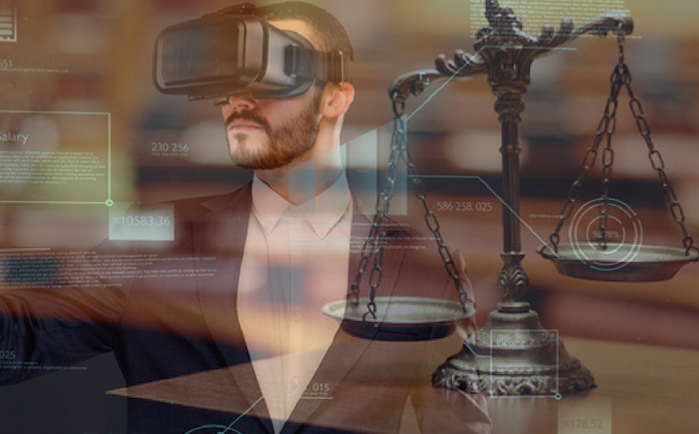Virtual Reality: The Next Patent Battleground – Part 1

I recently read of an interesting property dispute:
Sailor’s Cove is a relaxing waterfront community… with cobblestone streets and New England–style homes bordering the dock. Quaint boutiques line the rocky coast, as [residents] spend their days watching sailing events, yachting, or perusing the local bookshop. Sailor’s Cove is comprised of 21 private islands developed by Isabella Bentham, Tasha Kostolany, and Patrick Leavitt… In 2008 a dispute erupted between Leavitt and the other two “developers” when he attempted to assert ownership over the community and its assets… The parties settled out of court (Le, 2013).
This case doesn’t sound particularly unusual, and it isn’t, except for one thing – Sailor’s Cove exists only in the virtual world of Second Life. And it is one of many cases in the growing practice of virtual law, where lawyers litigate issues arising in virtual worlds, or that carry over from a virtual world to the real world.
I recently wrote several articles about the coming boom in virtual and augmented reality. Occurring with that boom, I believe, will be a simultaneous increase in legal action resulting from our activities in virtual worlds as well as the technologies that are used to create virtual and augmented reality.
Recent intellectual property cases over mobile phone technology, such as Apple v. Samsung, are an indicator of what’s coming in virtual and augmented reality, as companies maneuver to be a dominate provider of these important and growing technologies. The stakes were high with mobile phones, and they are likely to be as high or higher with augmented and virtual reality. Facebook, with its$2,000,000,000 purchase of Oculus, is already betting big on virtual reality. When the stakes are so high, litigation is certain to follow.
In fact, virtual reality “patent wars” maybe even bigger than the mobile phone patent wars, because people have been conceptualizing and patenting virtual and augmented reality technologies for years while the technologies have been largely dormant in the market. As adaptation quickly ramps up, which is now beginning to happen, holders of existing patents will be incentivized to take action to protect their intellectual property. Technology developers will also be increasingly incentivized to obtain new patents, under the “first to file” policy that came into effect in 2013.
This litigation will take many forms:
- Disputes such as Sailor’s Cove, where consequences of activities occurring in virtual worlds are litigated in the real world.
- Intellectual property and patent issues over the various technologies that are used to create virtual and augmented reality.
- Intellectual property disputes arising over activities in virtual worlds, such as the use of a real-world trademark in a virtual world.
- Product liability issues arising overuse of virtual and augmented reality, such as a headset-wearing user injuring him or herself.
- Privacy issues.
This article will take a closer look at the first type of dispute; then in a follow-on article I’ll take a closer look at the other four types of disputes.
I have already been involved as an expert witness in multiple lawsuits in the virtual reality space. My specialty is human factors and advanced user interfaces and these lawsuits typically have a user interface component – by definition, without the user interface there is no virtual or augmented world.
Virtual Worlds, Real Lawsuits
Some law firms specialize in litigating virtual cases, and many have set up storefronts in virtual worlds. There is even a Second Life Bar Association. These lawyers are adapting to practice in a virtual world; for example, because privacy cannot be guaranteed in virtual worlds, all attorney/client communications take place in the real world. They also need to be conscious of jurisdictional issues, as people who interact in virtual worlds may physically reside anywhere in the real world (Le, 2013).
This case involving virtual animal breeders provides an example of what is being litigated, in this case between two parties in the virtual world(Le, 2013):
In 2010 Ozimals, Inc., a virtual rabbit breeder, filed a DMCA takedown notice against Amaretto Ranch Breedables, LLC, which creates virtual horses. Both make and sell their own virtual food needed to keep the virtual animals alive. Ozimals contended that Amaretto copied the functionality of its virtual bunnies and asked that Linden Lab [the creator of Second Life] take down the infringing content. Amaretto filed a counterclaim, arguing that Ozimals misused the DMCA to decrease competition by having content removed before actual infringement was established. If Linden Lab followed through on the takedown notice, the company’s viability would be threatened, essentially eliminating Ozimals’ competition… In November 2012, [the judge] issued a summary judgment in the case dismissing in part Ozimals’ counterclaims, stating that the company does not have copyright ownership of the code that controlled the functionality of the virtual rabbits.
Disputes also arise between a virtual character and creators of the virtual world. One issue is that participants in virtual worlds often invest extensive time, effort, and money into creating virtual characters and possessions, which may be lost if their account is canceled(Le, 2013):
In Evans v. Linden Research, Inc. the plaintiffs fought for their virtual property rights, arguing that by suspending their accounts, Linden Lab deprived them of their virtual goods. The company asserted that, according to its terms of service, the plaintiffs only had rights to the intellectual property of goods created in-world, but not to the goods themselves. So when users violated the terms of service, Linden Lab said it was within its rights to cancel the plaintiffs’ membership to Second Life.
The value of virtual items in the real world is also likely to become an issue. Virtual worlds like Second Life have economies where goods are traded, and those economies are linked to real world economies. An example of this is The Virtual World Exchange, where Second Life Linden dollars can be traded for US dollars or Euros. Black markets also exist for selling virtual goods outside of their virtual world. These black markets are often contrary to the virtual world’s terms of service, but do arise outside of the virtual world.
Virtual items can even be stolen in the real world, as in the case of a Norwegian boy mugged and forced to give up a virtual amulet and mask from a role-playing game called Rune-Scape (Le, 2013). One of the attorneys appealed to the country’s Supreme Court, arguing that the items were “neither tangible nor material and, unlike for example, electricity, had no economic value.” The court rejected that notion, stating that the amulet and mask had “intrinsic” value to the boy because he worked hard to earn them. While they were not “material goods,” the boy was able to lose possession of these items to the defendants. In upholding the theft conviction, the court wrote that it was of the opinion that these virtual goods are to be included in the concept of “goods.” It is truly a brave new world.
Moving Forward
Virtual and augmented reality technology are finally coming to the masses and over the next five years will do so in a very big way. I believe that virtual reality will become a daily part of our lives, perhaps in a form we have not seen yet. I also believe that augmented reality is going to become increasingly more prominent as well. Google Glass was unsuccessful, but specialized augmented reality applications are emerging in business and are increasingly available to consumers via a variety of other manufacturers.
We need to be prepared for this. Protecting intellectual property, safeguarding against liability, and being cognizant of privacy issues will be critical in this new world, the rules are changing, and for many, the stakes will be very high.
References
- Le, T. P. (2013, May). More Than Just a Game. Retrieved April 1, 2016, from Washington Lawyer: https://www.dcbar.org/bar-resources/publications/washington-lawyer/articles/may-2013-virtual-game.cfm
Dr. Craig Rosenberg is an entrepreneur, human factors engineer, computer scientist, and expert witness. You can learn more about Dr. Rosenberg and his expert witness consulting business at www.ui.expert

